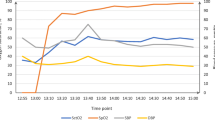Abstract
Hypoxic-ischemic cerebral injury that occurs during the perinatal period is one of the most commonly recognized cause of long-term neurological deficit in children, often referred to as cerebral palsy. We describe a case with capillary leak syndrome and seizures to co-morbid status epilepticus related to perinatal hypoxicischemic encephalopathy in newborn period.
Similar content being viewed by others
References
Shalak L, Perlman JM. Hypoxic-ischemic brain injury in the term infant-current concepts. Early Human Development 2004; 80: 125–141.
Hagberg H, Gilliaud E, Bona E. Enhanced expression of IL1 and IL6 m-RNA and bioactive proteins after hypoxia ischemia in neonatal rats. Pediatr Research 1996; 40: 603–609.
Zhang S, Wang S, Li Q et al. Capillary Leak Syndrome in children with C4A-deficiency undergoing cardiac surgery with cardiopulmonary bypass: a double-blind, randomised controlled study. Lancet 2005; 366: 556–562.
Seghaye MC, Grabitz RC, Duchateau J et al. Inflammatory reaction and capillary leak syndrome related to cardiopulmonary bypass in neonates undergoing cardiac operations. J Thorac Cardiovasc Surg 1996; 112: 687–697.
Short MA. Linking the sepsis triad of inflammation, coagulation, and supressed fibrinolysis to infants. Advances in Neonatal Care 2004; 4: 258–273.
Finn A, Naik S, Klein N, Levinsky RJ, Strobel S, Elliot M. Interleukin-8 release and neutrophil degranulation after pediatric cardiopulmonary bypass. J Thorac Cardiovasc Surg 1995; 105: 234–241.
Li Y, Chi L, Stechschulte DJ, Dileepan KN. Histamine-induced production of interleukin-6 and interleukin-8 by human coronary artery endothelial cells is enhanced by endotoxin and tumor necrosis factor-alpha. Microvasc Res 2001; 61: 253–262.
Guo YL, Kang B, Yang LJ, Williamson JR. Tumor necrosis factor- alpha and ceramide induce cell death through different mechanisms in rat mesangial cells. Am J Physiol 1999; 276: 390–397.
Dubinett SM, Huang M, Lichtenstein A et al. Tumor necrosis factor-alpha plays a central role in Interleukin-2 induced pulmonary vascular leak and lymphocyte accumulation. Cell Immunol 1994; 157: 170–80.
Suzuki M, Hayakawa F, Okumura A, Kato T, Kubota T, Maruyama K. High incidence of fatal cytokine-related disease among children with sequelae of perinatal hypoxicischemic encephalopathy. No To Hattatsu 2006; 38: 439–442.
Author information
Authors and Affiliations
Corresponding author
Rights and permissions
About this article
Cite this article
Karagol, B.S., Erdeve, O., Arsan, S. et al. Status epilepticus and capillary leak syndrome in a neonate related to perinatal hypoxic-ischemic encephalopathy. Indian J Pediatr 77, 439–441 (2010). https://doi.org/10.1007/s12098-010-0011-7
Received:
Accepted:
Published:
Issue Date:
DOI: https://doi.org/10.1007/s12098-010-0011-7




